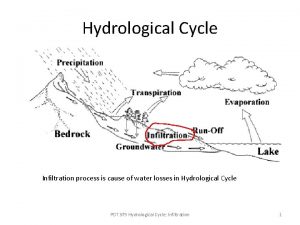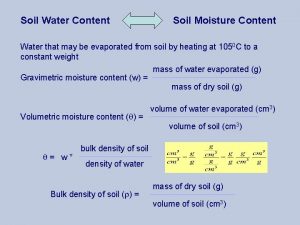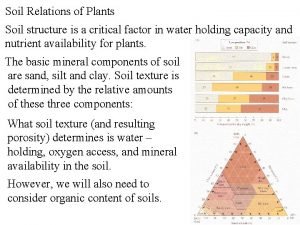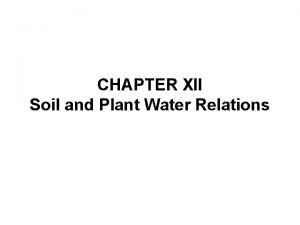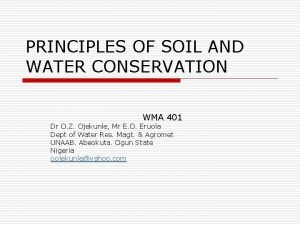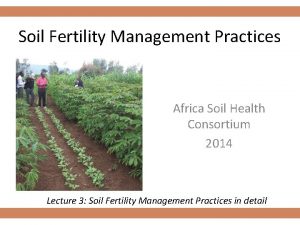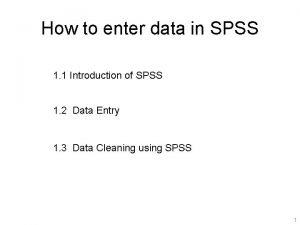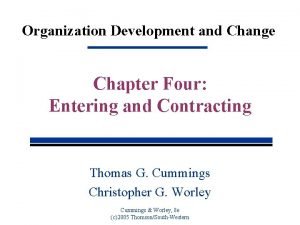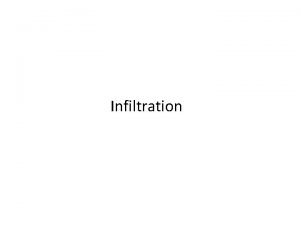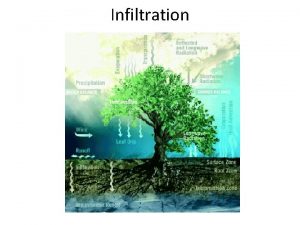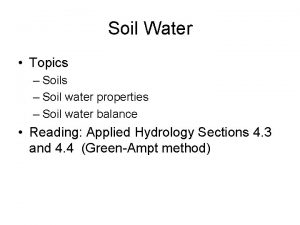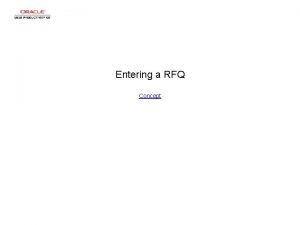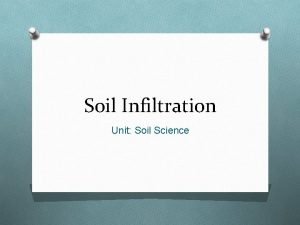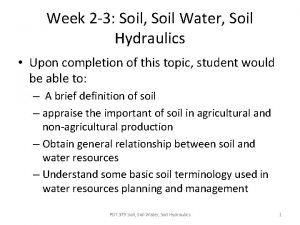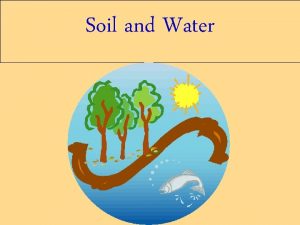Infiltration Infiltration Water entering the soil at the





























- Slides: 29

Infiltration

Infiltration Water entering the soil at the ground surface It replenishes the soil moisture deficiency and the excess moves downward by force of gravity called deep seepage or percolation and builds up the ground water table

Infiltration Capacity The maximum rate at which the soil in an given condition is capable of absorbing water

Infiltration often begins at a high rate (20 to 25 cm/hr) and decreases to a fairly steady state rate as rain continues, called the ultimate (= 1. 25 to 2. 0 cm/hr).

Infiltration

Infiltration The infiltration rate f at any time t is give by Horton’s equation Time Constant Initial rate of infiltration capacity Final constant rate of infiltration at saturation

Infiltration Shaded area in Figure

Infiltration The infiltration depends upon 1. 2. 3. 4. 5. 6. 7. The intensity and duration of rainfall Weather (Temperature) Soil characteristics Vegetal cover Land use Initial soil content (initial wetness) Trapped air and depth of the ground water table

Infiltration Methods of determining infiltration 1. 2. 3. 4. 5. Infiltrometers Observation in pits and ponds Placing a catch basin below a laboratory sample Artificial rain simulators Hydrograph analysis

Infiltration Double ring infiltrometer

Infiltration A double ring infiltrometer consists of two rings The two rings (22. 5 to 90 cm diameter) are driven into the ground by a driving plate and hammer, to depth of 15 cm. After driving is over, any disturbed soil adjacent to the sides tamped with a metal temper. Point gauges are fixed in the center of the rings and in the annular space between the two rings.

Infiltration Water is poured into the rings to maintain the desired depth (2. 5 to 15 cm with a minimum of 5 mm) and the water added to maintain the original constant depth at regular time intervals (after the commencement of the experiment) of 5, 10, 15, 20, 30, 40, 60 min, etc. Up to a period of at least 6 hours is noted and the results are plotted as infiltration rate in cm/hr vs. time in minutes.

Infiltration

Infiltration Example: In a double ring infiltrometer test, a constant depth of 100 mm was restored at every time interval the level dropped as given below: Time (min) Depth of water (mm) 0 5 10 15 25 45 60 75 90 100 130 100 83 87 90 85 78 85 85 85 80 80 • Establish the infiltration equation of the form developed by Horton

Infiltration

Infiltration (i) Plot on semi-log paper ‘ t vs. log (f-fc)

Infiltration

- Example : For a small catchment, the infiltration rate at the beginning of rain was observed to be 90 mm/hr and decreased exponentially to a constant rate of 8 mm/hr after 2. 30 hr. The total infiltration during 2. 30 hr was 50 mm. Develop the Horton’s equation for the infiltration rate at any time t< 2. 30 hr

Horton equation is :

Infiltration index It is the most commonly used method for determination of loss of rainwater due to abstraction. The method assumes a constant value for the intake rate of rainwater into the soil for the full duration of the storm. There are three types of infiltration indices: (i) φ-index (ii) W-index (iii) fave-index

Infiltration The infiltration index is also called the index. The index gives the index of the average abstraction of rainwater. The φ-index is defined as that rate of rainfall above which the rainfall volume equals the runoff volume. The φ-index is relatively simple and all losses due to infiltration, interception and depression storage (i. e. , storage in pits and ponds) The remaining volume of rainfall, which flows out as surface runoff is called the excess rainfall volume.


Infiltration Procedure for determination of the index 1. Draw the hyetograph of the storm rainfall and compute the total volume of rainfall. 2. Compute the excess runoff volume from the storm hydrograph by separating the base flow from it. 3. Subtract (2) from (1) to determine the total intake of rainwater into the soil.

Infiltration Procedure for determination of the index 4. Divide the value at (3) with the effective rainfall period to get the index (cm/hr) Index (cm/hr)=(total intake of water into the soil/ effective rainfall period)

Infiltration Example : A storm with 20 cm of precipitation produced a surface runoff of 11. 6 cm. estimate the index of the storm if the data recorded is as follows: Time (h) Incremental rainfall per hour (cm) 1 2 3 4 5 6 7 8 0. 8 1. 8 3. 0 4. 6 3. 2 2. 0 1. 0

Infiltration Solution : Infiltration of the rainwater into the soil = 20 – 11. 6 = 8. 4 cm The solution has to be found by selecting the effective rainfall period iteratively. Assume that the full length of the storm period, i. e. 8 hours is the effective rainfall period.

Infiltration Solution : Therefore Index = 8. 4/8 = 1. 05 cm/h However, this value of Index is more than the rainfall recorded during the first and the eighth hour respectively, which is not possible.

Infiltration Therefore, by assuming again that the effective rainfall period is 6 hours, we eliminate the chance for occurrence of any excess rainfall during the first and eighth hour respectively. Then for the 6 -hour effective time period, the infiltration loss is = 20 – 0. 8 – 1. 0 – 11. 6 = 6. 6 cm Therefore, index = 6. 6/6 = 1. 1 cm/h

Infiltration Rainfall intensity (cm/h) This value of is not more than any of the values of precipitation from the second to the seventh hour of the storm, and is, therefore, acceptable.
 Water and water and water water
Water and water and water water Soil infiltration rate
Soil infiltration rate Infiltration capacity of soil depends upon *
Infiltration capacity of soil depends upon * On a warm sunny day water in a glass
On a warm sunny day water in a glass Infiltration def water cycle
Infiltration def water cycle Infiltration water cycle
Infiltration water cycle Infiltration water cycle example
Infiltration water cycle example Mountain humidity
Mountain humidity Living soil vs dead soil
Living soil vs dead soil Four major spheres of the earth
Four major spheres of the earth What is soil
What is soil Water retention in soil
Water retention in soil Water content of soil
Water content of soil Soil texture water holding capacity
Soil texture water holding capacity Freshwater wetlands purify water by
Freshwater wetlands purify water by Soil and water relationship
Soil and water relationship Chapter 1 science and the environment
Chapter 1 science and the environment Water conservation objectives
Water conservation objectives The term geologists use for underground water is
The term geologists use for underground water is Poiseuille's equation
Poiseuille's equation Africa soil health consortium
Africa soil health consortium Texas soil and water conservation
Texas soil and water conservation Gonowufo
Gonowufo Importance of sanitation
Importance of sanitation Entering data in spss
Entering data in spss District health information management system ghana
District health information management system ghana What is data cleaning in spss
What is data cleaning in spss Dua for entering the house
Dua for entering the house Edward is entering a university
Edward is entering a university Interpersonal process issues in entering and contracting
Interpersonal process issues in entering and contracting






